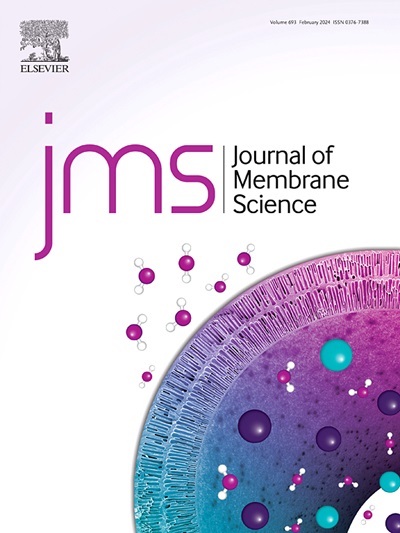Preparation and properties of superprotonic conductor-based mixed matrix proton exchange membranes for energy conversion and storage
IF 8.4
1区 工程技术
Q1 ENGINEERING, CHEMICAL
引用次数: 0
Abstract
The integration of crystalline metal-organic frameworks (MOFs) into polymer-based matrix to develop mixed matrix membranes (MMMs) is a rapidly growing research area, particularly in energy conversion and storage applications. Enhancing the loading capacity of MOFs in polymer matrices and improving interfacial compatibility are essential for preparing MMMs. This study involved the preparation of MMMs using a sulfonated microblock copolymer (SPP-3) with a high density of meta-ether oxygen bonds as the polymer matrix. The incorporation of the MOF-based superprotonic conductor UiO-66(SO3H)2 (USO) yielded the MMMs with up to 30 % loading and excellent dimensional stability, fabricated via conventional solvent evaporation. The ideal proton conductivity (PC) of the prepared MMMs achieved 165.0 mS cm−1 at 80 °C, representing a 34.38 % increase relative to the initial membrane. The peak power density (PPD) of proton exchange membrane fuel cells (PEMFCs) reached 387.7 mW cm−2. Notably, the positive correlation between the persistence length of hydrophobic structural domains in microblock copolymers and the effective contact area of crystalline MOFs was initially noted. This study proposed a new strategy for the fabrication of MMMs with high MOFs loading and investigated efficient interface compatibility.

基于超质子导体的混合基质质子交换膜的制备及性能研究
将晶体金属有机骨架(MOFs)集成到聚合物基基质中以开发混合基质膜(MMMs)是一个快速发展的研究领域,特别是在能量转换和存储应用方面。提高mof在聚合物基体中的负载能力和改善界面相容性是制备mmfs的关键。本研究采用一种磺化微嵌段共聚物(SPP-3),以高密度的间醚氧键为聚合物基体,制备了MMMs。mof基超质子导体uuo -66(SO3H)2 (USO)的掺入使mmmm具有高达30%的负载和优异的尺寸稳定性,通过传统的溶剂蒸发制备。制备的MMMs在80℃时的理想质子电导率(PC)达到165.0 mS cm−1,相对于初始膜提高了34.38%。质子交换膜燃料电池(pemfc)的峰值功率密度(PPD)达到387.7 mW cm−2。值得注意的是,微嵌段共聚物中疏水结构域的持续长度与结晶MOFs的有效接触面积之间存在正相关关系。本研究提出了一种制造高mof负载的mm材料的新策略,并研究了有效的界面相容性。
本文章由计算机程序翻译,如有差异,请以英文原文为准。
求助全文
约1分钟内获得全文
求助全文
来源期刊

Journal of Membrane Science
工程技术-高分子科学
CiteScore
17.10
自引率
17.90%
发文量
1031
审稿时长
2.5 months
期刊介绍:
The Journal of Membrane Science is a publication that focuses on membrane systems and is aimed at academic and industrial chemists, chemical engineers, materials scientists, and membranologists. It publishes original research and reviews on various aspects of membrane transport, membrane formation/structure, fouling, module/process design, and processes/applications. The journal primarily focuses on the structure, function, and performance of non-biological membranes but also includes papers that relate to biological membranes. The Journal of Membrane Science publishes Full Text Papers, State-of-the-Art Reviews, Letters to the Editor, and Perspectives.
 求助内容:
求助内容: 应助结果提醒方式:
应助结果提醒方式:


